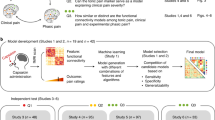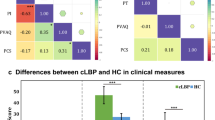Abstract
To date, pain perception is thought to be a creative process of modulation carried out by an interplay of pro- and anti-nociceptive mechanisms. Recent research demonstrates that pain experience constitutes the result of top–down processes represented in cortical descending pain modulation. Cortical, mainly medial and frontal areas, as well as subcortical structures such as the brain stem, medulla and thalamus seem to be key players in pain modulation. An imbalance of pro- and anti-nociceptive mechanisms are assumed to cause chronic pain disorders, which are associated with spontaneous pain perception without physiologic scaffolding or exaggerated cortical activation in response to pain exposure. In contrast to recent investigations, the aim of the present study was to elucidate cortical activation of somatoform pain disorder patients during baseline condition. Scalp EEG, quantitative Fourier-spectral analyses and LORETA were employed to compare patient group (N = 15) to age- and sex-matched controls (N = 15) at rest. SI, SII, ACC, SMA, PFC, PPC, insular, amygdale and hippocampus displayed significant spectral power reductions within the beta band range (12–30 Hz). These results suggest decreased cortical baseline arousal in somatoform pain disorder patients. We finally conclude that obtained results may point to an altered baseline activity, maybe characteristic for chronic somatoform pain disorder.


Similar content being viewed by others
Abbreviations
- EEG:
-
Electroencephalogram
- BA:
-
Brodman area
- rCBF:
-
Regional cerebral blood flow
- SMA:
-
Supplementary motor area
- PPC:
-
Posterior parietal cortex
- PFC:
-
Prefrontal cortex
- SI:
-
Primary somatosensory cortex
- SII:
-
Secondary somatosensory cortex
- ACC:
-
Anterior cingulate cortex
- rACC:
-
Rostral anterior cingulate cortex
- PAG:
-
Periaqueductal grey
- AI:
-
Anterior insula
- CBP:
-
Chronic back pain patients
- IBS:
-
Irritable bowel syndrome
- GI:
-
Gastrointestinal
- EOG:
-
Electrooculogram
- ICA:
-
Independent component analysis
References
Anderer P, Saletu B, Kinsperger K, Semlitsch H (1987) Topographic brain mapping of EEG in neuropsychopharmacology–part I. Methodological aspects. Meth Find Expt Clin Pharmacol 9(6):371–384
Baliki MN, Chialvo DR, Geha PY, Levy RM, Harden RN, Parrish TB, Apkarian AV (2006) Chronic pain and the emotional brain: specific brain activity associated with spontaneous fluctuations of intensity of chronic back pain. J Neurosci 26(47):12165–12173
Bingel U, Lorenz J, Schoell E, Weiller C, Büchel C (2005) Mechanisms of placebo analgesia: rACC recruitment of a subcortical anti-nociceptive network. Pain 120:8–15
Bingel U, Schoell E, Büchel C (2007) Imaging pain modulation in health and disease. Curr Opin Neurol 20:424–431
Bingel U, Schoell E, Herken W, Büchel C (2007) Habituation to painful stimulation involves the antinociceptive system. Pain 131:21–30
Birbaumer N, Schmidt F (2003) Biologische Psychologie. Springer, Berlin
Brand S, Gerber M, Pühse U, Holsboer-Trachsler E (2009) The relation between sleep and pain among a non-clinical sample of young adults. Eur Arch Psychiatry Clin Neurosci, 2010 March 31 (Epub ahead of print)
Casey KL, Lorenz J, Minoshima S (2003) Insights into the pathophysiology of neuropathic pain through functional brain imaging. Exp Neurol 184(Suppl 1):S80–S88
Chang L (2005) Brain responses to visceral and somatic stimuli in irritable bowel syndrome: a central nervous system disorder? Gastroenterol Clin North Am 34(2):271–279
de Charms RC, Maeda F, Glover GH, Ludlow D, Pauly JM, Doneji D, Gabrieli JDE, Mackey SC (2005) Control over brain activation and pain learned by using real-time functional MRI. PNAS 102(51):18626–18631
Derbyshire SW, Whalley MG, Stenger VA, Oakley DA (2004) Cerebral activation during hypnotically and imagined pain. NeuroImage 23:392–401
Dilling H, Mombour W, Schmidt H (2005) Internationale Klassifikation psychischer Störungen ICD-10 Kapitel V(F), 5. durchgesehene und ergänzte Auflage. Hans Huber
Fields HL (2000) Pain modulation: expectation, opioid analgesia and virtual pain. Prog Brain Res 122:245–253
Garcia-Campayo J, Fayed N, Serrano-Blanco A, Roca M (2009) Brain dysfunction behind functional symptoms. Neuroimaging and somatoform, conversive, and dissociative disorders. Curr Opin Psychiatry 22:224–231
Garcia-Campayo J, Magdalena J, Magallon R, Fernandez-Garcia, Salas M, Andres E (2008) A meta-analysis of the efficacy of fibromyalgia treatment according to level of care. Arthritis Res Ther 10(R81)
Gracely RH, Geisser ME, Giesecke T, Grant MA, Petzke F, Williams DA, Clauw DJ (2004) Pain catastrophizing and neural responses to pain among persons with fibromyalgia. Brain 127(Pt 4):835–843
Hegerl U, Stein M, Mulert C, Mergl R, Olbrich S, Dichgans E, Rujescu D, Pogarell O (2008) EEG-vigilance differences between patients with borderline personality disorder, patients with obsessive-compulsive disorder and healthy controls. Eur Arch Psychiatry Clin Neurosci 258:137–143
Jensen M, Grierson C, Tracy-Smith V, Bacigalupi S, Othmer S (2007) Neurofeedback treatment for pain associated with complex regional pain syndrome type I. J Neurother 11(1)
Linden DEJ (2008) Brain imaging and psychotherapy: methodological considerations and practical implications. Eur Arch Psychiatry Clin Neurosci 258(Suppl 5):71–75
May A (2007) Neuroimaging: visualising the brain in pain. Neurol Sci 28(Suppl 2):101–107
Mease PJ (2009) Further strategies for treating fibromyalgia: the role of serotonin and norepinephrine reuptake inhibitors. Am J Med 122(Suppl 12):44–55
Moisett X, Bouhassira D (2007) Brain imaging in neuropathic pain. NeuroImage 37:80–88
Moore RA, Straube S, Wiffen PJ, Derry S, McQuay HJ (2009) Pregabalin for acute and chronic pain in adults. Cochrane Database Syst Rev 8(3):CD007076
Nunez P, Silberstein B (2000) On the relationship of synaptic activity to macroscopic measurements: does co-registration of EEG with fMRI make sense? Brain Topogr 13(2)
Peters ML, Schmidt AJ, Hout MA (1989) Chronic low back pain and the reaction to repeated acute pain stimulation. Pain 39:69–76
Petrovic P, Petersson KM, Ghatan PH, Stone-Elander S, Ingvar M (2000) Pain-related cerebral activation is altered by a distracting cognitive task. Pain 85(1–2):19–30
Petrovic P, Kalso E, Petersson KM, Ingvar M (2002) Placebo and opioid analgesia: imaging a shared neuronal network. Science 295:1737–1740
Peyron R, Laurent B, Garcia-Larrea L (2000) Functional imaging of brain responses to pain. A review and meta-analysis. Neurophysiol Clin 30:263–288
Rosen R, Buckner R, Dale A (1998) Event-related functional MRI: past, present, and future. Natl Acad Sci USA 95:773–780
Saletu B, Anderer P, Saletu-Zyhlarz GM, Pascual-Marqui RD (2005) EEG mapping and low-resolution brain electromagnetic tomography (LORETA) in diagnosis and therapy of psychiatric disorders: evidence for a key-lock principle. Clin EEG Neurosci 36(2):108–115
Saletu B, Krizjer F, Ferber G, Anderer P (2000) Electrophysiological brain Research in preclinical and clinical pharmacology and related fields—an update. Faculas Universitätsverlag Vienna
Sarnthein J, Stern J, Aufenberg C, Rousson V, Jeanmonod D (2006) Increased EEG power and slowed dominant frequency in patients with neurogenic pain. Brain 129:55–64
Sarnthein J, Jeanmonod D (2008) High thalamocortical theta coherence in patients with neurogenic pain. NeuroImage 39:1910–1917
Schmidt-Wilcke T, Leinisch E, Ganssbauer S, Draganski B, Bogdahn U, Altmeppen J, May A (2006) Affective components and intensity of pain correlate with structural differences in gray matter in chronic back pain patients. Pain 125(1–2):89–97
Schneider F, Backes V, Mathiak K (2009) Brain imaging: on the way toward a therapeutic discipline. Eur Arch Psychiatry Clin Neurosci 259(Suppl 2):S143–S147
Schnitzler A, Ploner M (2000) Neurophysiology and functional neuroanatomy of pain perception. J Clin Neurophysiol 17(6):592–603
Schulman J, Zonenshayn M, Ramirez R, Ribary U, Llinas R (2005) Thalamocortical dysrhythmia syndrome: MEG imaging of neuropathic pain. Thalamus Relat Syst 3:33–39
Stern J, Jeanmonod D, Sarnthein J (2006) Persistent EEG overactivation in the cortical pain matrix of neurogenic pain patients. NeuroImage 31:721–731
Wilder-Smith CJ, Schindler D, Lovblad K (2004) Brain functional magnetic resonance imaging of rectal pain and activation of endogenous inhibitory mechanisms in irritable bowel syndrome patient subgroups and healthy controls. Gut 35:1595–1601
Author information
Authors and Affiliations
Corresponding author
Additional information
An erratum to this article can be found at http://dx.doi.org/10.1007/s00406-010-0168-0
Rights and permissions
About this article
Cite this article
Stefanie, K., Peter, A., Gerda, SZ. et al. Dysfunctional pain modulation in somatoform pain disorder patients. Eur Arch Psychiatry Clin Neurosci 261, 267–275 (2011). https://doi.org/10.1007/s00406-010-0148-4
Received:
Accepted:
Published:
Issue Date:
DOI: https://doi.org/10.1007/s00406-010-0148-4




